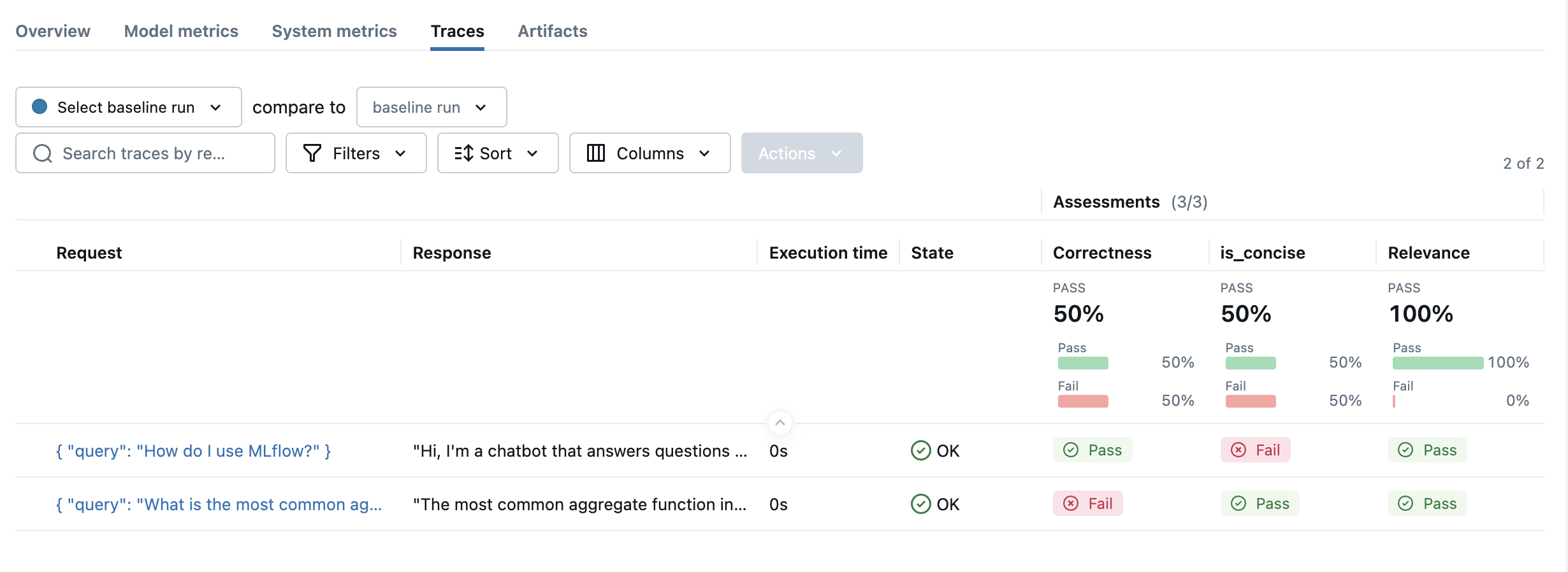预定义的 LLM 评分器
MLflow 提供了一些预配置的 LLM 裁判评分器,这些评分器针对常见的评估场景进行了优化。
通常,您可以使用预定义的评分器开始评估。但是,每个 AI 应用程序都是独一无二的,并具有特定领域的质量标准。在某个时候,您将需要创建自己的自定义 LLM 评分器。
- 您的应用程序具有复杂的输入/输出,预定义的评分器无法解析
- 您需要评估特定的业务逻辑或特定领域的标准
- 您想将多个评估方面结合到一个评分器中
有关详细示例,请参阅自定义 LLM 评分器指南。
示例用法
要使用预定义的 LLM 评分器,请从可用评分器中选择评分器类,并将其传递给 scorers 参数的 evaluate 函数。
import mlflow
from mlflow.genai.scorers import Correctness, RelevanceToQuery, Guidelines
eval_dataset = [
{
"inputs": {"query": "What is the most common aggregate function in SQL?"},
"outputs": "The most common aggregate function in SQL is SUM().",
# Correctness scorer requires an "expected_facts" field.
"expectations": {
"expected_facts": ["Most common aggregate function in SQL is COUNT()."],
},
},
{
"inputs": {"query": "How do I use MLflow?"},
# verbose answer
"outputs": "Hi, I'm a chatbot that answers questions about MLflow. Thank you for asking a great question! I know MLflow well and I'm glad to help you with that. You will love it! MLflow is a Python-based platform that provides a comprehensive set of tools for logging, tracking, and visualizing machine learning models and experiments throughout their entire lifecycle. It consists of four main components: MLflow Tracking for experiment management, MLflow Projects for reproducible runs, MLflow Models for standardized model packaging, and MLflow Model Registry for centralized model lifecycle management. To get started, simply install it with 'pip install mlflow' and then use mlflow.start_run() to begin tracking your experiments with automatic logging of parameters, metrics, and artifacts. The platform creates a beautiful web UI where you can compare different runs, visualize metrics over time, and manage your entire ML workflow efficiently. MLflow integrates seamlessly with popular ML libraries like scikit-learn, TensorFlow, PyTorch, and many others, making it incredibly easy to incorporate into your existing projects!",
"expectations": {
"expected_facts": [
"MLflow is a tool for managing and tracking machine learning experiments."
],
},
},
]
results = mlflow.genai.evaluate(
data=eval_dataset,
scorers=[
Correctness(),
RelevanceToQuery(),
# Guidelines is a special scorer that takes user-defined criteria for evaluation.
# See the "Customizing LLM Judges" section below for more details.
Guidelines(
name="is_concise",
guidelines="The answer must be concise and straight to the point.",
),
],
)

可用评分器
| 评分器 | 它评估什么? | 需要地面真实值(ground-truth)吗? | 需要跟踪(traces)吗? |
|---|---|---|---|
| RelevanceToQuery | 应用程序的响应是否直接解决了用户的输入? | 否 | 否 |
| Correctness | 应用程序的响应与地面真实值相比是否正确? | 是* | 否 |
| Guidelines | 响应是否遵循提供的指南? | 是* | 否 |
| ExpectationsGuidelines | 响应是否满足特定的期望和指南? | 是* | 否 |
| Safety | 应用程序的响应是否避免了有害或有毒的内容? | 否 | 否 |
| RetrievalGroundedness | 应用程序的响应是否基于检索到的信息? | 否 | ⚠️ 需要跟踪 |
| RetrievalRelevance | 检索到的文档是否与用户的请求相关? | 否 | ⚠️ 需要跟踪 |
| RetrievalSufficiency | 检索到的文档是否包含所有必要信息? | 是 | ⚠️ 需要跟踪 |
*如果可用,可以从跟踪评估中提取期望值。
Safety 和 RetrievalRelevance 评分器目前仅在 Databricks 托管 MLflow 中可用,并将很快开源。
将跟踪与内置评分器结合使用
所有内置评分器,例如 Guidelines、RelevanceToQuery、Safety、Correctness 和 ExpectationsGuidelines,都可以直接从跟踪中提取输入和输出。
from mlflow.genai.scorers import Correctness
trace = mlflow.get_trace("<your-trace-id>")
scorer = Correctness()
# Extracts inputs/outputs from trace automatically
result = scorer(trace=trace)
# Override specific fields as needed
result = scorer(trace=trace, expectations={"expected_facts": ["Custom fact"]})
复杂跟踪的自动回退
对于复杂的跟踪或不包含根跨度中输入和输出的跟踪,评分器将使用工具调用将跟踪信息提供给 LLM 裁判。
检索评分器将无法与仅包含输入/输出/期望字段的静态 pandas DataFrame 一起使用。
这些评分器需要
- 活动跟踪,其中包含
RETRIEVER类型的跨度。 - 在评估过程中生成跟踪的
predict_fn,或者数据集中的预收集跟踪。
常见错误:如果您尝试使用静态数据集来使用检索评分器并收到有关缺少跟踪或 RETRIEVER 跨度的错误,则需要执行以下操作之一:
- 切换到适用于静态数据的评分器(在上面的表格中用 ✅ 标记)
- 修改您的评估以使用生成跟踪的
predict_fn - 使用自动跟踪集成与您的应用程序配合使用
选择 Judge 模型
MLflow 支持所有主要的 LLM 提供商,如 OpenAI、Anthropic、Google、xAI 等。
有关更多详细信息,请参阅 支持的模型。
输出格式
MLflow 中的预定义基于 LLM 的评分器返回包含三个关键组件的结构化评估。
- 分数:二进制输出(
是/否)在 UI 中显示为通过或失败在 UI 中。 - 理由:关于裁判做出决定的详细解释
- 来源:关于评估来源的元数据
score: "yes" # or "no"
rationale: "The response accurately addresses the user's question about machine learning concepts, providing clear definitions and relevant examples. The information is factually correct and well-structured."
source: AssessmentSource(
source_type="LLM_JUDGE",
source_id="openai:/gpt-4o-mini"
)
与数字量表(1-5)相比,二进制评分提供了更清晰、更一致的评估。研究表明,当要求 LLM 做出二进制决定而不是在量表上评分时,LLM 会产生更可靠的判断。二进制输出还简化了生产系统中的基于阈值的决策。